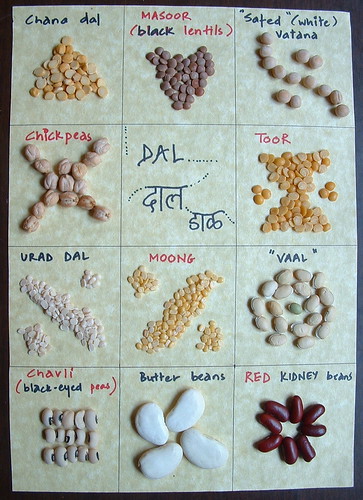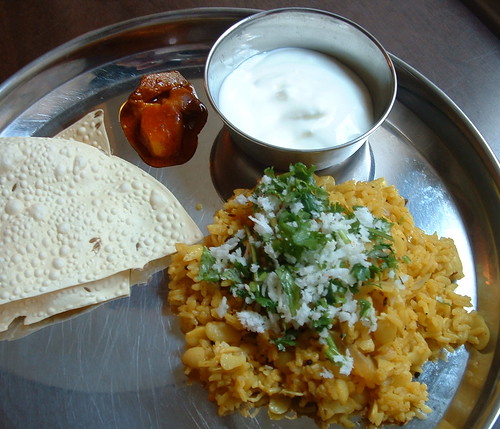This article is first of a special series called "The A-Z of Marathi food". India is the land of diversity. Each of the 28 states in India has a unique cuisine but the Indian food served in restaurants represents only a tiny fraction of our culinary heritage. I come from the western Indian state of Maharashtra. Capital: Bombay (Mumbai.) Population: 96 million (only 11 countries in the world have a population higher than Maharashtra.) Language: Marathi. Traditional Marathi food is earthy and humble, diverse and very tasty. It also remains relatively unknown to those outside the state. It's time to change that. I invite you to join me on an alphabetical culinary tour of my home state. We will go through the letters A to Z and make a dish with each letter to showcase the cuisine that I grew up on.
D is for Dalimbay Bhaat
Today we continue the journey with the letter "D", another letter with lots of foodie potential! Thank you all for some great "D" suggestions.
Dairy foods hold an important place in the predominantly vegetarian Indian diet, and Dahi (yogurt) and Dudh (milk) both happen to be "D" words. Yogurt has many nutritional benefits and most Marathi meals are served with home-made yogurt as a side dish. I confess that I don't consume enough yogurt to actually make it myself, making do with the weekly jar of branded store-bought yogurt instead. But if anyone wants to try their hand at making Dahi, Indira has written a very informative post about making home-made Yogurt. Yogurt is eaten plain, as a side-dish but itself also forms part of some delicious recipes. One of the most popular "chaat" foods showcasing Dahi is the Dahi Vada that I made recently.
Other "D"s include some wonderful vegetables, including Dudhi (a cousin of the pumpkin with pale green skin and milky flesh), Dhabbu mirchi (the green pepper or capsicum, the word literally means "chubby pepper"!) and my personal favorite, the ridge gourd or Dodka.
But the most far-reaching "D" food has to be Dal. A simple three-letter word which is all inclusive of the peas, beans and lentils that are the seeds of legume plants. Dals are a miracle food...nutritionally, they are rich in protein and fiber while being low in fat; dals can be dried and stored for long periods, thus being available year-round, the variety of dals means that you need never be bored eating rice-and-dal; and even ecologically, legume plants play an important role in "fixing" nitrogen in the soil and enriching it. What's not to love, right?
I decided to peek into my kitchen and check out how many types of dals I really have on hand. Total: 11, and a few jars are empty, to be refilled on my next visit to the Indian store. Here is the gallery of the dals I have on hand, demonstrating the amazing variety; in size, from the wee moong dal to the gigantic butter beans; in color from the pale urad dal to the dark lentils; in shape and indeed, taste.
A Gallery of Dals
The inspiration for this decorative arrangement came from the Indian folk-art of Rangoli in which colored powders are artfully used to make beautiful geometric patterns on the floor. The word "dal" is written in english, hindi and marathi, the three languages I know and love.
All whole beans can be easily sprouted to make them even more nutritious. I have already blogged about recipes using many of these dals, including Toor Dal, Chavli/Black-Eyed Peas, Whole Lentils, Urad Dal, Chana Dal and Kidney Beans.
Dals can form the base for other tasty dishes. One really interesting dal dish is a pasta-like recipe which uses dal as the sauce: Mika wrote about this delicious dish, called Dal Dhokli a few months ago.
So what am I making today? I chose a bean that is very popular in Marathi cuisine, a tasty bean called Vaal or Dalimbay. This bean has a pleasant slightly bitter flavor ( the same way greens are pleasantly bitter). Dalimbay are made into a curry or a rice (bhaat) and the latter is what I chose to make for a nice simple Sunday lunch.
The beans first need to be sprouted:
This is what they look like (1) in the dry state (2) after overnight soaking (3) after 2 days of sprouting. These sprouted beans then have to be peeled. The peel pops right off and it is even easier to do if you place the sprouted beans in a bowl of warm water. Now making the rice is really easy; Bhaat in Marathi means rice.
Dalimbay Bhaat
(serves 4-6)
1 cup rice, uncooked
1 1/2 cup dalimbay beans, sprouted and peeled
1 onion, sliced
5-6 curry leaves
1/2 tsp mustard seeds
1/2 tsp cumin seeds
1/2 tsp turmeric
1/2 tsp red chilli powder/cayenne pepper
1 tsp garam masala/ amti masala
1 tsp coriander powder
1/2 tsp cumin powder
salt to taste
2 tbsp oil
2 tbsp minced cilantro
2 tbsp grated coconut (fresh or frozen)
Method:
1. Heat oil and make a "tadka" with mustard and cumin seeds.
2. Add curry leaves and onion and fry till onion is cooked and transluscent.
3. Add turmeric, chilli powder, garam masala/amti masala, coriander powder, cumin powder, salt and saute for a few seconds.
4. Add rice and beans and saute till coated with all the spices.
5. Add 3 cups water, bring to a boil and then simmer, covered, till rice and beans are tender and done.
6. Garnish with cilantro and coconut.
Serve hot with pickles, papad and yogurt.
Hope you enjoyed the "D" foods...next we come to "E" which is a bit of a challenge! Would anyone like to give any ideas with this one?




hi nupur
ReplyDeletewhat a beautiful illustration of the different daals - so visually stunning. you're so creative! just discovered your blog. i'm a vegetarian from mumbai myself so i look forward to trying some of your recipes.
Hi Nupur,
ReplyDeleteGreat blog you have here!
Please come and visit mine which is dedicated to international and Swiss cuisine/specialities.
Regards,
Rosa
www.rosas-yummy-yums.blogspot.com/
I can't wait to come back and read about dal, but I had to comment on your photos - outstanding!
ReplyDeleteI'd love to learn how to make a really good dal....
Hi Nupur,
ReplyDeleteI couldn't wait till I see you tomorrow to tell you how pretty this is, ........... simply lovely. This definitely has to be the prettiest thing you have done till now.
Sujayita
Hi Nupur!
ReplyDeletewow this looks great!!!
I am loving this series thankyou!
I'm so happy you started this series just as I'm starting to cooking Indian food. I feel like I'm getting a mini-lesson each time I read one of your very informative posts-thank you!
ReplyDeleteAmy
Wow!!! I am stunned by the amount of effort you put into these things! Nice.
ReplyDeleteE is difficult. Maybe Egg Curry? Or Elaichi Chai?
Hi Nupur, I am having some computer problems so the late comment.
ReplyDeleteThank you for mentioning my post about yogurt. I appreciate it.
Your rangoli presentation of dals is simply unique and beautiful.
I never had val dal before. I shall try it. Thanks for sharing another great recipe!
Lulu, thanks! hope the recipes work out well for you!
ReplyDeleteHi Rosa, thanks for stopping by.
Hi Lindrusso, its really easy to make a good dal..I hope you get a chance to try it sometime!
Hi Suj, thanks :)
Hey Clare, glad you like it :)
Hi Amy, Its turning out to be such a learning experience for me too!
Hi Anya, I was thinking along the same lines! E is hard!
Hi Indira, Vaal takes a bit more effort due to the peeling but really is worth it, its very tasty.
The dish sounds really yummy! I love this series and I LOVE your little dal illustration board! :) I have to organize my spices to see which ones I have missing so I can finally try one of your tempting posts!
ReplyDeletehi nupur, the dals look grt.
ReplyDeletenow for e, theres idli[pronounced with e] but its not maharashtrian. there's a v authentic mithai which begins with e ...imrati[todyachi jilabi]. if you remember the fancy deep orange jilabis which look like the gold tode[ay]often displayed in marathi mithai shops this is it. of course making it at home is too difficult...........so egg curry[bindachi curry aji style] .......or imli chutney ........all the best.love, yoma.
Hi Nupur-
ReplyDeleteIts 4:30 pm where I am and I am famished, someone decided to clean out the vending machine today so there nothing to be had for another hour and a half until I get home. So I decided to read thru some food blogs ( not a good idea when hungry ) and came upon yours. Thoroughly enjoyed reading your posts, the photographs are making my head spin! Would you happen to have a good recepie for thalipeeth ( photographs would be an added bonus of course ).
Thanks.
Hi joey, thanks for stopping by :)
ReplyDeleteHey yoma, you are brimming with ideas as usual! The tode mithai sounds really interesting...I have never seen it before.
Hi George, I know how you feel! Food blogs are a bad bad idea when famished :)
You know, I do have a thalipeeth recipe...but I get the flour from India (it is a mixture of different grains and dals, all ground together). I can definitely look into how you can make the flour at home. I was saving thalipeeth for the "T" on my A-Z series, think you can wait a few months :) Otherwise, definitely mail me (address on my blog above), and I'll mail you whatever I know about making thalipeeth.
Hi Nupur,
ReplyDeleteI love your dhal poster! It's absolutely cute! It's also useful to compare how different the dhals look next to one another. Thanks for this informative series! I've been enjoying every single post so far. :)
Hi Julia,
ReplyDeletethanks! I love writing this series too :) it has become the highlight of my week.
Hi Nupur- I tried sprouting vaal. They get spoilt and become sort of grayish. Any tips on how to sprout them? Can they be used without sprouting?
ReplyDeleteMika, the only reason I can think of why vaal could spoil during sprouting is: they might be getting water-logged. Are they in a colander/mesh where the excess water can drain out? I find that rinsing them twice a day, letting the water drain each time, keeps them from spoiling.
ReplyDeleteI have never used vaal without sprouting...the problem being that the skin is pretty tough and hard to remove unless the vaal is sprouted.
Hey, congratulations on the great photo for DMBLGIT.
ReplyDeleteAre dalimbay beans the same as fava beans?
ReplyDeleteNupur, I made this rice today for flavors of Maharashtra event host by Pj. The rice came out good. Thanks for sharing!
ReplyDeletemy vaal also became sticky and started some getting grayish after 24 hrs. so i just peeled the skin and used it without waiting for it to sprout.
ReplyDeleteNice blog!
ReplyDelete